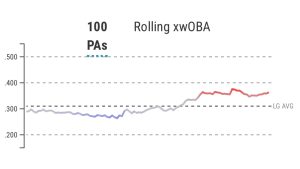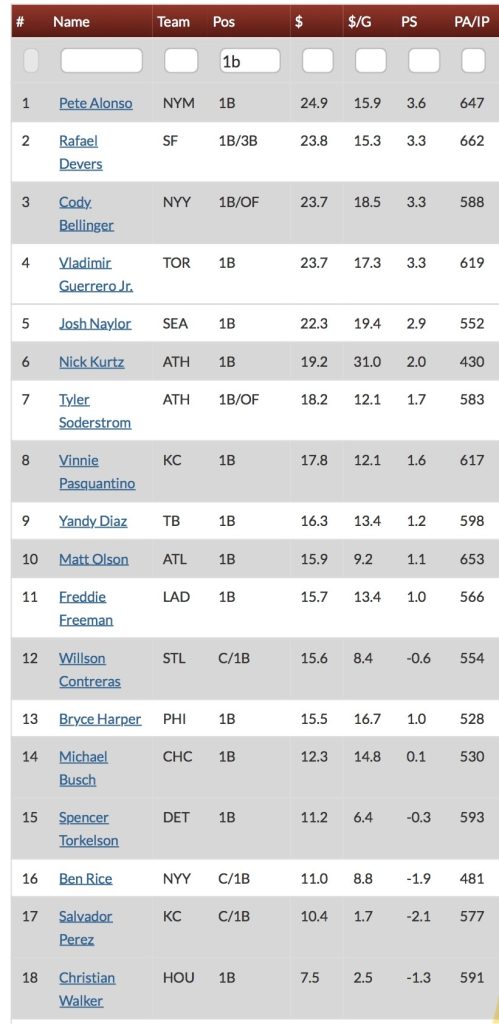The 2025 fantasy baseball season is nearing its close, and while some managers are laser-focused on championship week, many of us have already shifted our eyes toward 2026 draft boards. This is the time of year when frustrations and regrets from the spring resurface, especially with the players who were selected in the early rounds but never lived up to their billing. A handful of big names that once carried heavy draft capital instead carried the burden of inconsistency, forcing managers into endless lineup debates and second-guessing every start or sit decision. This week, our hitter profiles spotlight those maddening players who seemed to have the talent on paper but tested the patience of fantasy managers all summer long. The question now is whether these disappointing seasons are simply bumps in the road that can lead to value rebounds or whether they signal long-term declines that should push these players down draft boards. Not every disappointing year turns into a career spiral, just as not every rebound can match the kind of revival Trevor Story has delivered in 2025. Our goal is to separate the names worth buying back into from the ones that will leave you chasing past glory and regretting it again in 2026.
Ozzie Albies
Albies checks in at #157 on the Razzball PlayerRater after being selected in the fifth round on average in the spring. Coming off a rough 2024 in which he managed 99 games with 10 homers and eight steals to pair with a .251 average, fantasy managers were expecting a bounce back in 2025. Instead, they have been treated to more of the same, as he has performed 13 percent below league average by wRC+, even worse than his 2024 mark. While he has managed to stay on the field all season, there appeared to be plenty of rust, as he had just nine homers, nine steals, and a .218 average through July 28. Granted, his .241 BABIP was abnormally low compared to his career .288 figure. However, since then, Albies has shown signs of life.

Since July 29, in 42 games, he has essentially matched his production from the first two thirds of the season. Over that stretch, he has seven homers, five steals, and a .288 average as his luck normalized. That said, this has not been simply a case of bad luck. Albies has not been making strong contact, and some of his underlying metrics have declined. Most concerning is the continued drop in his speed profile. What was once a top 15th percentile sprint speed is now below average, even as league-wide running has surged in recent years. At this point, Albies still has value, but his peak appears to be something like 20 homers, 15 steals, and a .260 average across a full season if health cooperates. To earn comeback player of the year consideration, he will need both health and luck. Looking to 2026, Albies projects more as a middle infield option than an early round pick.
Marcus Semien
When it comes to middle infielders prone to up and down seasons, Marcus Semien is the poster child. He sits at #212 on the PlayerRater. After four straight seasons of 160 or more games played, he is likely to miss the remainder of 2025 with a broken foot. In the 127 games he did manage, he turned in a well below average season with a .230 average, 15 homers, and 11 steals. His strikeout rate climbed to its highest point in five years, and he swung at the first pitch at the highest rate of his career. Clearly, a challenging season pushed him into pressing at the plate.
On the other side of the coin, he also posted the second lowest BABIP of his career despite still grading in the 80th percentile in sprint speed. From a power perspective, he also recorded the second lowest HR/FB rate of his career. Semien’s fantasy value has always been driven by subtle shifts in his profile and where luck lands. He will be 35 years old in 2026, but under the hood the skills remain fairly similar to the last five years. With younger players emerging, Semien is slipping in the rankings but should still be considered a starting second baseman in fantasy, and one who should be ranked a tier above Albies heading into 2026.
Christian Walker
A big offseason contract and move to Houston looked like an ideal match on paper, but 2025 has been underwhelming. Walker sits at #152 on the PlayerRater. After averaging more than 30 homers and nearly 100 RBI in each of the previous three seasons, Houston expected his pull-heavy approach to thrive with the Crawford Boxes in left field. Instead, he has managed just 22 homers with a .236 average. While the overall line does not look disastrous, his lack of speed and middling run production have left him as only the 18th most valuable first baseman this season, behind players like Ben Rice and Michael Busch.

Walker will be 35 on Opening Day 2026, and his profile is showing signs of age. First, his quality of contact and plate discipline have clearly eroded. After punishing breaking balls at a .296 clip with a .577 slugging percentage in 2024, those numbers have collapsed to a .197 average and .379 slugging. His approach has grown much more aggressive, with a 37 percent first pitch swing rate compared to 25 percent the year prior. Combine that with his highest chase rate since 2021, and the decline appears skill-based rather than luck-driven. Looking ahead, Walker will need to make multiple adjustments to his approach and stave off further age-related decline, which is a tall order. For 2026, he profiles more as a corner infield option with a concerning floor.
Mookie Betts
Mookie Betts was an undisputed first round pick in 2025 but has returned only modest value, sitting at #97 on the PlayerRater. Hitting atop a strong Dodgers lineup should have produced premium counting stats, yet he may not score 100 runs this season. His 18 homers also mark his lowest full-season total since 2015 if we exclude 2020. To add to the disappointment, Betts may not even reach double digits in steals, as he sits at eight in ten attempts this late in the season. He had posted double digit steals every season since his rookie year. For a first round pick, this has been a frustrating return, though there are recent signs of life.

Since August 5, Betts has hit .341 with seven homers and 49 combined runs and RBI, good for a 168 wRC+. That is the level of production managers hoped for on draft day. Over that stretch, he has walked more than he has struck out and posted a 45 percent hard hit rate. The glaring issue is speed. He is now a below average runner, grading at the 35th percentile in sprint speed. Without running, his fantasy profile looks much less appealing in the early rounds. Betts can still deliver value, but his days as a multi-category contributor are likely over. Unless he adds speed back into his game, he projects as more of a middle round draft target in 2026, which is not much more intriguing than Marcus Semien.


